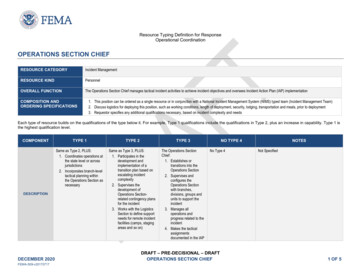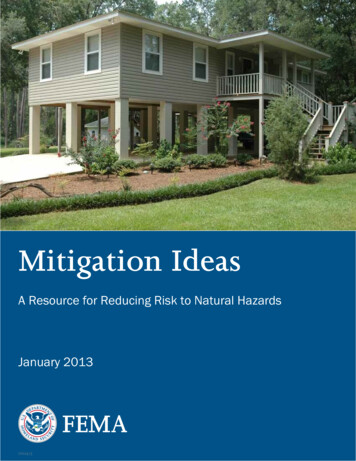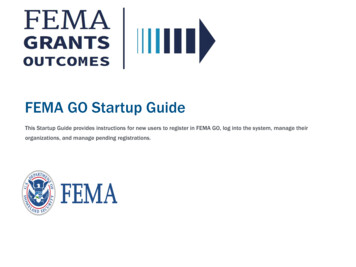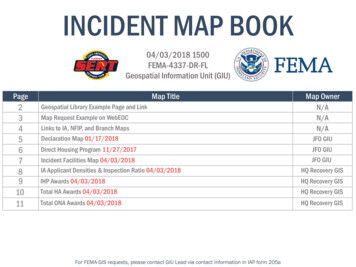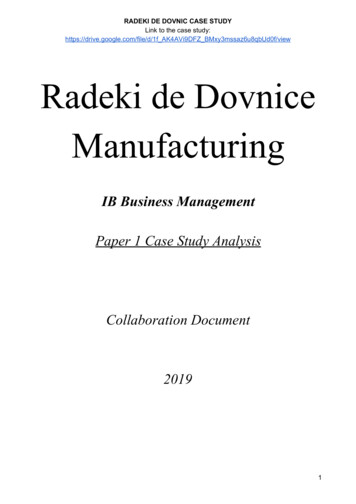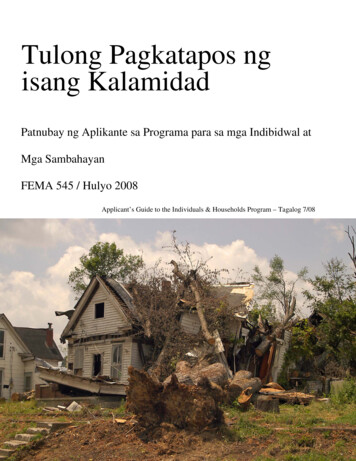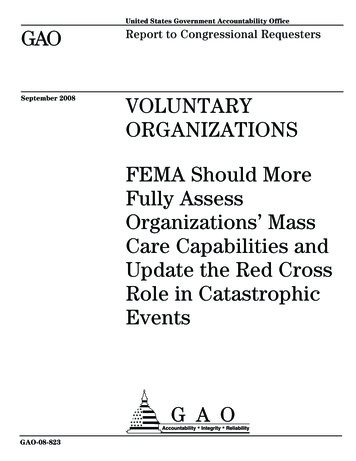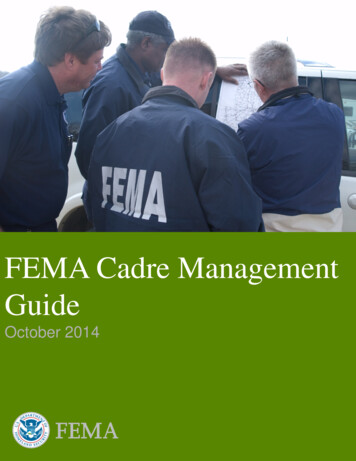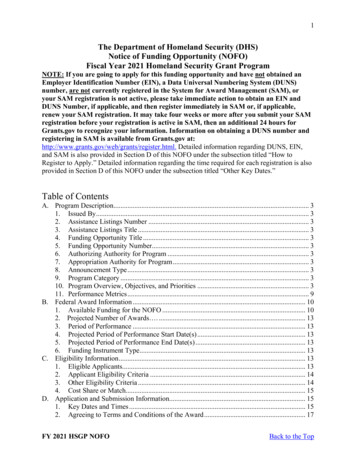
Transcription
1The Department of Homeland Security (DHS)Notice of Funding Opportunity (NOFO)Fiscal Year 2021 Homeland Security Grant ProgramNOTE: If you are going to apply for this funding opportunity and have not obtained anEmployer Identification Number (EIN), a Data Universal Numbering System (DUNS)number, are not currently registered in the System for Award Management (SAM), oryour SAM registration is not active, please take immediate action to obtain an EIN andDUNS Number, if applicable, and then register immediately in SAM or, if applicable,renew your SAM registration. It may take four weeks or more after you submit your SAMregistration before your registration is active in SAM, then an additional 24 hours forGrants.gov to recognize your information. Information on obtaining a DUNS number andregistering in SAM is available from Grants.gov at:http://www.grants.gov/web/grants/register.html. Detailed information regarding DUNS, EIN,and SAM is also provided in Section D of this NOFO under the subsection titled “How toRegister to Apply.” Detailed information regarding the time required for each registration is alsoprovided in Section D of this NOFO under the subsection titled “Other Key Dates.”Table of ContentsA. Program Description. 31. Issued By. 32. Assistance Listings Number . 33. Assistance Listings Title . 34. Funding Opportunity Title . 35. Funding Opportunity Number. 36. Authorizing Authority for Program . 37. Appropriation Authority for Program . 38. Announcement Type . 39. Program Category . 310. Program Overview, Objectives, and Priorities . 311. Performance Metrics . 9B. Federal Award Information . 101. Available Funding for the NOFO . 102. Projected Number of Awards . . 133. Period of Performance . 134. Projected Period of Performance Start Date(s) . 135. Projected Period of Performance End Date(s) . 136. Funding Instrument Type. 13C. Eligibility Information . 131. Eligible Applicants. 132. Applicant Eligibility Criteria . 143. Other Eligibility Criteria . 144. Cost Share or Match. 15D. Application and Submission Information. 151. Key Dates and Times . 152. Agreeing to Terms and Conditions of the Award . 17FY 2021 HSGP NOFOBack to the Top
23.4.Address to Request Application Package . 17Steps Required to Obtain a Unique Entity Identifier, Register in the System for AwardManagement (SAM), and Submit an Application . 175. Electronic Delivery . 186. How to Register to Apply through Grants.gov . 187. How to Submit an Initial Application to FEMA via Grants.gov . 188. Submitting the Final Application in ND Grants . 199. Timely Receipt Requirements and Proof of Timely Submission . 1910. Content and Form of Application Submission. 2011. Other Submission Requirements. 3212. Intergovernmental Review . 3213. Funding Restrictions and Allowable Costs . 32E. Application Review Information . 411. Application Evaluation Criteria . 412. Review and Selection Process . 43F. Federal Award Administration Information . 461. Notice of Award. 462. Pass-Through Requirements . 473. Administrative and National Policy Requirements. 484. Reporting. 515. Monitoring and Oversight . 51G. DHS Awarding Agency Contact Information . 521. Contact and Resource Information . 522. Systems Information . 53H. Additional Information . 531. Termination Provisions . 542. Period of Performance Extensions . 54FY 2021 HSGP NOFOBack to the Top
3A. Program Description1. Issued ByU.S. Department of Homeland Security (DHS)/Federal Emergency Management Agency(FEMA)/Grant Programs Directorate (GPD)2. Assistance Listings Number97.0673. Assistance Listings TitleHomeland Security Grant Program4. Funding Opportunity TitleFiscal Year 2021 Homeland Security Grant Program (HSGP) State Homeland Security Program (SHSP) Urban Area Security Initiative (UASI) Operation Stonegarden (OPSG)5. Funding Opportunity NumberDHS-21-[GPD]-[067]-[00]-[02]6. Authorizing Authority for ProgramSection 2002 of the Homeland Security Act of 2002 (Pub. L. No. 107-296, as amended) (6U.S.C. § 603)7. Appropriation Authority for ProgramDepartment of Homeland Security Appropriations Act, 2021 (Pub. L. No. 116-260)8. Announcement TypeInitial9. Program CategoryPreparedness: Community Security10. Program Overview, Objectives, and Prioritiesa. OverviewThe Fiscal Year (FY) 2021 Homeland Security Grant Program (HSGP) is one of three grantprograms that constitute the DHS/FEMA focus on enhancing the ability of state, local, tribal,and territorial governments, as well as nonprofits, to prevent, protect against, respond to, andrecover from terrorist attacks. These grant programs are part of a comprehensive set ofmeasures authorized by Congress and implemented by DHS to help strengthen the Nation’scommunities against potential terrorist attacks. Among the five basic homeland securitymissions noted in the DHS Strategic Plan, HSGP supports the goal to Strengthen NationalPreparedness and Resilience.FY 2021 HSGP NOFOBack to the Top
4In FY 2021, there are three components of HSGP:1) State Homeland Security Program (SHSP): SHSP assists state, local, tribal, andterritorial efforts to build, sustain, and deliver the capabilities necessary to prevent,prepare for, protect against, and respond to acts of terrorism.2) Urban Area Security Initiative (UASI): UASI assists high-threat, high-density UrbanArea efforts to build, sustain, and deliver the capabilities necessary to prevent,prepare for, protect against, and respond to acts of terrorism.3) Operation Stonegarden (OPSG): OPSG supports enhanced cooperation andcoordination among Customs and Border Protection (CBP), United States BorderPatrol (USBP), and federal, state, local, tribal, and territorial law enforcement agenciesto improve overall border security. OPSG provides funding to support joint efforts tosecure the United States’ borders along routes of ingress/egress to and frominternational borders, to include travel corridors in states bordering Mexico andCanada, as well as states and territories with international water borders. State, local,tribal, and territorial (SLTT) law enforcement agencies utilize their inherent lawenforcement authorities to support the border security mission and do not receive anyadditional authority as a result of participation in OPSG.The 2018-2022 FEMA Strategic Plan creates a shared vision for reducing the risks posed byterrorism and sets an ambitious, yet achievable, path forward to unify and furtherprofessionalize emergency management across the country. HSGP supports the goals ofBuilding a Culture of Preparedness and Readying the Nation for Catastrophic Disasters. Weinvite our stakeholders and partners to also adopt these priorities and join us in building amore prepared and resilient Nation, as preparedness is a shared responsibility and fundingshould support priorities that are most impactful and demonstrate the greatest return oninvestment.For FY 2021, DHS is focused on the criticality of information sharing and collaboration tobuilding a national culture of preparedness and protecting against terrorism and otheremerging threats to our national security. DHS and its homeland security mission were bornfrom the “failures among federal agencies and between the federal agencies and state andlocal authorities to share critical information related to the threat of terrorism” prior to theSeptember 11, 2001, attacks. 1 The threat profile has changed in the past two decades – wenow face continuous cyber threats by sophisticated actors, threats to soft targets and crowdedplaces, threats from domestic violent extremists, and threats from new and emergingtechnologies. But information sharing and cooperation among state, local, and tribalauthorities and federal agencies, including all DHS officials, is just as vital, and perhaps evenmore vital, today. Therefore, for FY 2021, we have identified five priority areas, tied to someof the most serious threats that DHS would like to see addressed by state and localHomeland Security Act of 2002: Report Together with Minority and Dissenting Views 222, Select Committee onHomeland Security: 107th Congress, U.S. House of Representatives (2002) (H. Rpt. 107-609).1FY 2021 HSGP NOFOBack to the Top
5governments, that recipients will need to address with their HSGP funds. Perhaps mostimportantly, we will be focused on forging partnerships to strengthen information sharingand collaboration in each of these priority areas and looking for recipients to remove barriersto communication and cooperation with DHS and other federal agencies.b. ObjectiveThe objective of the FY 2021 HSGP is to fund state, local, tribal, and territorial efforts toprevent terrorism and prepare the Nation for threats and hazards that pose the greatest risk tothe security of the United States.c. PrioritiesGiven the evolving threat landscape, it is incumbent upon DHS/FEMA to continuouslyevaluate the national risk profile and set priorities that help ensure appropriate allocation ofscarce security dollars. In assessing the national risk profile for FY 2021, five priority areasattract the most concern. Due to the unique threats that the nation faces in 2021, DHS/FEMAhas determined that these five priorities should be addressed by allocating specificpercentages of SHSP and UASI funds to each of these five areas, for a total of 30 percent peraward. The following are the five priority areas for FY 2021, along with the correspondingpercentage of SHSP and UASI funds that each recipient will be required to designate to eachpriority area in order to obtain a full allocation of SHSP and UASI funds:1) Enhancing cybersecurity – 7.5 percent2) Enhancing the protection of soft targets/crowded places – 5 percent3) Enhancing information and intelligence sharing and analysis, and cooperation withfederal agencies, including DHS – 5 percent4) Combating domestic violent extremism – 7.5 percent5) Addressing emergent threats (e.g., transnational criminal organizations, unmannedaircraft systems [UASs], weapons of mass destruction [WMD], etc.) – 5 percentFailure by a recipient to propose investments and projects that align with the five priorityareas and spending requirements will result in a recipient having a portion of their SHSP andUASI funds (up to 30 percent) placed on hold until they provide projects that sufficientlyalign to the National Priority Areas, and total at least the minimum percentage identifiedabove of total SHSP and UASI funds per National Priority Area.A state or high-risk urban area must allocate the remaining 70 percent of their funding togaps identified through their Threat and Hazard Identification and Risk Assessment (THIRA)and Stakeholder Preparedness Review (SPR) process.Likewise, there are several enduring security needs that crosscut the homeland securityenterprise to which recipients should consider allocating funding across core capability gapsand national priorities. The following are enduring needs that help recipients implement acomprehensive approach to securing communities:1) Effective planning;2) Training and awareness campaigns;FY 2021 HSGP NOFOBack to the Top
63) Equipment and capital projects; and4) Exercises.SHSP and UASI Funding PrioritiesThe table below provides a breakdown of the FY 2021 SHSP and UASI priorities (the focusof OPSG remains unique to border security), showing the core capabilities enhanced andlifelines supported, as well as examples of eligible project types for each area. A detaileddescription of allowable investments for each project type is included in the PreparednessGrants Manual. DHS/FEMA anticipates that in future years, national priorities will continueto be included and will be updated as the threats evolve and as capability gaps are closed.Applicants are strongly encouraged to begin planning to sustain existing capabilities throughfunding mechanisms other than DHS preparedness grants.FY 2021 SHSP & UASI Funding PrioritiesPriority AreasCore CapabilitiesNational PrioritiesEnhancing CybersecurityCybersecurity Intelligence and informationsharing Planning Public information andwarning Operational coordination Screening, search, anddetection Access control and identityverification Supply chain integrity andsecurity Risk management forprotection programs andactivities Long-term vulnerabilityreduction Situational assessment Infrastructure systems Operational communicationsEnhancing the Operational coordinationProtection of Public information andSoft Targets/warningCrowded Places Intelligence and informationsharing Interdiction and disruption Screening, search, anddetection Access control and identityverification Physical protective measures Risk management forprotection programs andactivitiesFY 2021 HSGP NOFOLifelinesExample Project Types Safety andSecurity Cybersecurity risk assessments Migrating online services to the “.gov”internet domain Projects that address vulnerabilitiesidentified in cybersecurity riskassessmentso Improving cybersecurity of criticalinfrastructure to meet minimum levelsidentified by the Cybersecurity andInfrastructure Security Agency (CISA)o Cybersecurity training and planning Safety andSecurity Operational overtime Physical security enhancementso Closed-circuit television (CCTV)security cameraso Security screening equipment forpeople and baggageo Lightingo Access controlso Fencing, gates, barriers, etc.Back to the Top
7Priority AreasEnhancinginformation andintelligencesharing andanalysis, andcooperation withfederal agencies,including DHSCore Capabilities Intelligence and informationsharing Interdiction and disruption Planning Public information andwarning Operational coordination Risk management forprotection programs andactivitiesLifelines Safety andSecurityCombatingDomesticViolentExtremism Interdiction and disruption Screening, search anddetection Physical protective measures Intelligence and informationsharing Planning Public information andwarning Operational coordination Risk management forprotection programs andactivities Safety andSecurityAddressingEmergentThreats, such asthe activities ofTransnationalCriminalOrganizations,open sourcethreats, andthreats fromUAS and WMDEnduring NeedsPlanning Interdiction & disruption Screening, search anddetection Physical protective measures Intelligence and informationsharing Planning Public Information andWarning Operational Coordination Safety andSecurity Planning Safety andSecurityFY 2021 HSGP NOFOExample Project Types Fusion center operations (Fusion Centerproject will be required under thisinvestment, no longer as a stand-aloneinvestment) Information sharing with all DHScomponents; fusion centers; otheroperational, investigative, and analyticentities; and other federal lawenforcement and intelligence entities Cooperation with DHS officials and otherentities designated by DHS inintelligence, threat recognition,assessment, analysis, and mitigation Identification, assessment, and reportingof threats of violence Joint intelligence analysis training andplanning with DHS officials and otherentities designated by DHS Open source analysis of misinformationcampaigns, targeted violence and threatsto life, including tips/leads, andonline/social media-based threats Sharing and leveraging intelligence andinformation, including open sourceanalysis Execution and management of threatassessment programs to identify, evaluate,and analyze indicators and behaviorsindicative of domestic violent extremists Training and awareness programs (e.g.,through social media, suspicious activityreporting [SAR] indicators and behaviors)to help prevent radicalization Training and awareness programs (e.g.,through social media, SAR indicators andbehaviors) to educate the public onmisinformation campaigns and resourcesto help them identify and report potentialinstances of domestic violent extremism Sharing and leveraging intelligence andinformation UAS detection technologies Enhancing WMD and/or improvisedexplosive device (IED) prevention,detection, response and recoverycapabilitieso Chemical/Biological/Radiological/Nuclear/Explosive (CBRNE)detection, prevention, response, andrecovery equipment Development of:o Security Risk Management PlansBack to the Top
8Priority AreasCore Capabilities Risk management forprotection programs andactivities Risk and disaster resilienceassessment Threats and hazardsidentification Operational coordination Community resilienceLifelinesTraining &Awareness Long-term vulnerabilityreduction Public information andwarning Operational coordination Situational assessment Community resilience Safety andSecurityEquipment &Capital Projects Long-term vulnerabilityreduction Infrastructure systems Operational communications Interdiction and disruption Screening, search anddetection Access control and identityverification Physical protective measures Long-term vulnerabilityreduction Operational coordination Operational communications Community resilience Safety andSecurityExercises Safety andSecurityExample Project Typeso Threat Mitigation Planso Continuity of Operations Planso Response Plans Efforts to strengthen governanceintegration between/among regionalpartners Joint training and planning with DHSofficials and other entities designated byDHS Cybersecurity training and planning Active shooter training Intelligence analyst training SAR and terrorism indicators/behaviorstraining Security training for employees Public awareness/preparedness campaigns Joint training and planning with DHSofficials and other entities designated byDHS Cybersecurity training and planning Protection of high-risk, high-consequenceareas or systems that have been identifiedthrough risk assessments Physical security enhancementso Security cameras (CCTV)o Security screening equipment forpeople and baggageo Lightingo Access Controls Fencing, gates, barriers, etc. Response exercisesFor FY 2021, each SHSP and UASI recipient is required to submit an InvestmentJustification (IJ) for each of the five National Priority Areas identified above. Each of thesefive investments must also account for at least the relevant minimum percentage of theapplicant’s SHSP and UASI allocation. The fusion center project must be included under theInformation and Intelligence Sharing IJ. State Administrative Agencies (SAAs) may submitcomplete project-level information at the time of application, including the five NationalPriority Area IJs, but are not required to do so. As a reminder, all SHSP- and UASI-fundedprojects must have a demonstrated nexus to preventing, preparing for, protecting against, andresponding to acts of terrorism. However, such projects may simultaneously supportenhanced preparedness for disasters unrelated to acts of terrorism.DHS/FEMA also requires SHSP and UASI recipients (states, territories, and high-risk urbanareas) to complete a THIRA/SPR and prioritize grant funding to support closing capabilitygaps or sustaining capabilities that address national priorities and/or support enduring needs.FY 2021 HSGP NOFOBack to the Top
9Additional information on the THIRA/SPR process, including other National PreparednessSystem (NPS) tools and resources, can be found at https://www.fema.gov/nationalpreparedness-system. Detailed information on THIRA/SPR timelines and deadlines can befound in the Preparedness Grants Manual.OPSG Funding PrioritiesThe table below provides a breakdown of the FY 2021 OPSG funding priorities, whichremain focused on and unique to border security.FY 2021 OPSG Funding PrioritiesPriority AreasCore CapabilitiesNational PrioritiesLifelinesExample Project TypesEnhancinginformation andintelligencesharing andanalysis, andcooperation withfederal agencies,including DHS Intelligence andinformation sharing Safety andSecurityAddressingEmergentThreats, such asthe activities ofTransnationalCriminalOrganizations Interdiction & disruption Screening, search anddetection Physical protectivemeasures Intelligence andinformation sharing Safety andSecurity Participation in the DHS/ICE 287(g)training program Information sharing with all DHScomponents; fusion centers; otheroperational, investigative, and analyticentities; and other federal lawenforcement and intelligence entities Cooperation with DHS officials and otherentities designated by DHS inintelligence, threat recognition,assessment, analysis, and mitigation Identification, assessment, and reportingof threats of violence Joint intelligence analysis training andplanning with DHS officials and otherentities designated by DHS Operational overtime for border securityoperations as directed by the applicable,USBP-approved operations order Sharing and leveraging intelligence andinformationFor FY 2021, each OPSG applicant is required to clearly articulate and identify how theConcept of Operations addresses each of the two national priorities identified above.11. Performance MetricsPerformance metrics for this program:SHSP and UASI: Percentage of funding allocated by the recipient to core capabilities to build or sustainnational priorities identified in the section aboveFY 2021 HSGP NOFOBack to the Top
10OPSG: Number of contacts that occurred as a result of OPSG deploymentso Number of arrests that resulted from OPSG contactso Value of drug seizures that resulted from OPSG contactsB. Federal Award Information1. Available Funding for the NOFO:HSGP ProgramsSHSPUASIOPSGTotal 1,120,000,000.00FY 2021 Allocation 415,000,000 615,000,000 90,000,000 1,120,000,000SHSP AllocationsFor FY 2021, DHS/FEMA will award SHSP funds based on DHS/FEMA’s relative riskmethodology and statutory minimums pursuant to the Homeland Security Act of 2002, asamended. THIRA/SPR results do not impact grant allocation or award.Each state and territory will receive a minimum allocation under the SHSP using thresholdsestablished in the Homeland Security Act of 2002, as amended. All 50 States, the District ofColumbia, and the Commonwealth of Puerto Rico will receive 0.35 percent of the total fundsallocated for grants under Section 2003 and Section 2004 of the Homeland Security Act of2002, as amended. Each of the four territories (American Samoa, Guam, the NorthernMariana Islands, and the U.S. Virgin Islands) will receive a minimum allocation of 0.08percent of the total funds allocated for grants under Section 2003 and 2004 of the HomelandSecurity Act of 2002, as amended.Each state must include a separate IJ for each of the five National Priority Areas identified inthe Priorities section, above. All projects related to the National Priority Area must beincluded in the IJ. The funding level in each National Priority Area investment must equalor exceed the percentage for that respective National Priority Area, calculated as apercentage of the state’s SHSP allocation in the table below.FY 2021 SHSP ALLOCATIONSState/TerritoryAlabamaAlaskaAmerican SamoaArizonaArkansasCaliforniaColoradoFY 2021 HSGP NOFOFY 2021Allocation 4,602,500 4,602,500 1,052,000 4,602,500 4,602,500 59,220,807 4,602,500State/TerritoryMontanaNebraskaNevadaNew HampshireNew JerseyNew MexicoNew YorkFY 2021Allocation 4,602,500 4,602,500 4,602,500 4,602,500 7,345,897 4,602,500 70,639,800Back to the Top
11State/TerritoryConnecticutDelawareDistrict of settsMichiganMinnesotaMississippiMissouriTotalFY 2021Allocation 4,602,500 4,602,500 5,280,222 9,701,894 5,491,278 1,052,000 4,602,500 4,602,500 14,427,260 4,602,500 4,602,500 4,602,500 4,602,500 4,602,500 4,602,500 7,345,897 6,428,138 5,280,222 4,602,500 4,602,500 4,602,500State/TerritoryNorth CarolinaNorth DakotaNorthern Mariana IslandsOhioOklahomaOregonPennsylvaniaPuerto RicoRhode IslandSouth CarolinaSouth DakotaTennesseeTexasU.S. Virgin IslandsUtahVermontVirginiaWashingtonWest VirginiaWisconsinWyomingFY 2021Allocation 5,280,222 4,602,500 1,052,000 6,428,138 4,602,500 4,602,500 8,447,973 4,602,500 4,602,500 4,602,500 4,602,500 4,602,500 18,908,141 1,052,000 4,602,500 4,602,500 8,447,973 6,428,138 4,602,500 4,602,500 4,602,500 415,000,000UASI AllocationsEligible candidates for the FY 2021 UASI program are identified in the table below.Eligibility has been determined through an analysis of relative risk of terrorism faced by the100 most populous Metropolitan Statistical Areas (MSAs) in the United States, in accordancewith the Homeland Security Act of 2002, as amended. Detailed information on MSAs ispublicly available from the United States Census Bureau cro.html. THIRA/SPR results do notimpact grant allocation or award.The following table identifies the UASI allocations for each high-risk urban area based onDHS/FEMA’s relative risk methodology pursuant to the Homeland Security Act of 2002, asamended.In its application, each high-risk urban area, through the state, must include a separate IJ foreach of the five National Priority Areas identified in the Priorities section, above. Allprojects related to the National Priority Area must be included in the IJ. The fundinglevel in each National Priority Area investment must equal or exceed the percentage for thatrespective National Priority Area, calculated as a percentage of the urban area’s UASIallocation in the table below.FY 2021 HSGP NOFOBack to the Top
122021 UASI oDistrict of husettsMichiganMinnesotaMissouriNevadaNew Jer
priority area in order to obtain a full allocation of SHSP and UASI funds: 1) Enhancing cybersecurity - 7.5 percent 2) Enhancing the protection of soft targets/crowded places - 5 percent 3) Enhancing information and intelligence sharing and analysis, and cooperation with federal agencies, including DHS - 5 percent

